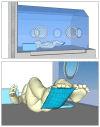Light or Deep Pressure: Medical Staff Members Differ Extensively in Their Tactile Stimulation During Preterm Apnea
- PMID: 32257984
- PMCID: PMC7089873
- DOI: 10.3389/fped.2020.00102
Light or Deep Pressure: Medical Staff Members Differ Extensively in Their Tactile Stimulation During Preterm Apnea
Abstract
Background: Even though tactile stimulation is common practice to terminate preterm apnea, the style and intensity of these interventions is not specified during theoretical or practical training and has never been clinically evaluated. Objective: The present study was designed to analyze the various modes of tactile stimulation used to terminate preterm apnea and measure the pressure intensity and frequency of these stimulations. Methods: A model with the size and weight of an actual preterm infant was equipped with sensor technology to measure stimulation pressure and frequency of tactile stimulation. Additionally a camera system was used to record hand positions and stimulation modes. Seventy medical staff members took part in the experiment. Results: We found extreme between subjects differences in stimulation pressure that could not be explained by professional experience but, to a degree, depended on apnea intensity. Pressures ranged from 11.11 to 226.87 mbar during low intensity apnea and from 9.89 to 428.15 mbar during high intensity apnea. The majority of participants used rhythmic stimulation movements with a mean frequency of ~1 Hz. Different modes (rubbing, squeezing, tickling, and tapping) and finger positions were used. Conclusion: Medical staff members intuitively adjust their tactile stimulation pressure depending on the premature infants' apnea intensity. However, mean pressure values varied greatly between subjects, with similar pressure ranges for low and high intensity apnea. The question remains which pressure intensities are necessary or sufficient for the task. It is reasonable to assume that some stimulation types may be more effective in rapidly terminating an apneic event.
Keywords: apnea of prematurity; neonatology; pressure sensor; stimulation frequency; treatment; very low birth weight.
Copyright © 2020 Martin, Thome, Grunwald and Mueller.
Figures



Similar articles
-
Effect of Tactile Stimulation on Termination and Prevention of Apnea of Prematurity: A Systematic Review.Front Pediatr. 2018 Mar 2;6:45. doi: 10.3389/fped.2018.00045. eCollection 2018. Front Pediatr. 2018. PMID: 29552548 Free PMC article.
-
Tactile Stimulation to Stimulate Spontaneous Breathing during Stabilization of Preterm Infants at Birth: A Retrospective Analysis.Front Pediatr. 2017 Apr 3;5:61. doi: 10.3389/fped.2017.00061. eCollection 2017. Front Pediatr. 2017. PMID: 28421171 Free PMC article.
-
A multicentre neonatal manikin study showed a large heterogeneity in tactile stimulation for apnoea of prematurity.Acta Paediatr. 2024 Jul;113(7):1519-1523. doi: 10.1111/apa.17234. Epub 2024 Apr 2. Acta Paediatr. 2024. PMID: 38563520
-
[Sensory stimulations for the treatment of idiopathic apneas of prematurity].Arch Pediatr. 2007 May;14(5):485-9. doi: 10.1016/j.arcped.2007.01.013. Epub 2007 Feb 22. Arch Pediatr. 2007. PMID: 17320360 Review. French.
-
Current options in the management of apnea of prematurity.Clin Pediatr (Phila). 2000 Jun;39(6):327-36. doi: 10.1177/000992280003900602. Clin Pediatr (Phila). 2000. PMID: 10879934 Review.
Cited by
-
The effect of sensory stimulation on apnea of prematurity.J Taibah Univ Med Sci. 2021 Dec 10;17(2):311-319. doi: 10.1016/j.jtumed.2021.10.016. eCollection 2022 Apr. J Taibah Univ Med Sci. 2021. PMID: 35592810 Free PMC article.
-
Caregivers' response to cardiorespiratory events in preterm infants in the NICU - A quantitative overview.Acta Paediatr. 2025 Jan;114(1):92-99. doi: 10.1111/apa.17407. Epub 2024 Aug 31. Acta Paediatr. 2025. PMID: 39215764 Free PMC article.
-
The effect of weighted blankets on sleep and related disorders: a brief review.Front Psychiatry. 2024 Apr 15;15:1333015. doi: 10.3389/fpsyt.2024.1333015. eCollection 2024. Front Psychiatry. 2024. PMID: 38686123 Free PMC article. Review.
References
LinkOut - more resources
Full Text Sources

